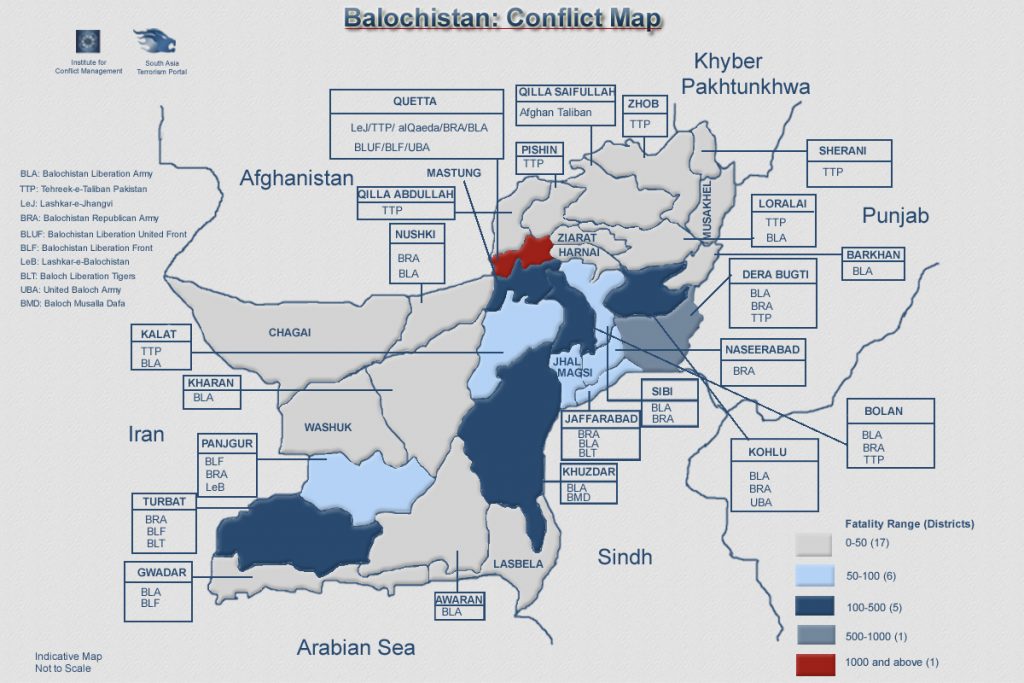
Background
The landscape of Baluchistan is comprised of an area over half a million square kilometers in the southeastern part of the Iran plateau, south of the central deserts and the Helmand river. The Baluchs are the main ethnic group in the province, followed by Pashtuns. The majority of the inhabitants are Sunni Muslims. A small number of Shia’s and Hindus also reside in the province. The province is divided between three countries: Afghanistan, Pakistan and Iran. The largest part of Baluchistan belongs to Pakistan. In spite of the natural resources in the Baluchistan province including chromites, fluorite, marble, gold, gas, iron and petroleum which are of prominent importance , it has remained one of the poorest provinces in Pakistan. The province has been marginalized throughout history. The history of the conflict in the province goes back to the independence of Pakistan in 1947. The first conflict arose in 1948, when Kalat, a part of the current Baluchistan, chose independence. This was followed by further conflict in 1958-59 and 1963-69. These conflicts were about the One Unit policy and military bases in Baluchistan. In 1973-79 President Bhutto dismissed the provincial government of Baluchistan, which led to an armed insurgency and revolt. From 2005 to now, there have been several issues driving the protracted conflict in the province such as the attack on General Shujaat Zamir, Inspector of the Frontier Corps of Pakistan and his deputy in Baluchistan Province in 2005, killing of the 79 year old Baluch political leader Nawab Akbar Khan Bugti in 2006, detention of the two leaders of the Baluch movement in 2009, and the announcement of the Council for Independent Baluchistan by Mir Suliman Dawood the Khan of Kalat in late 2009. The Islamic Republic of Pakistan has accused the army of Baluchistan of engaging in violent incidents.
The conflict in the Baluchistan province is an ongoing conflict between the inhabitants of the Baluchistan province and the government of Pakistan. This paper will address the unstable politics and ethnicity, resource and development issues, human rights, Islamic extremism and terrorist groups, foreign support, and education as the main root causes of the conflict.
a) Unstable Politics and Ethnicity:
The Baluch people have never had their required representation in politics, including the military. Sometimes they were not able to complete their tenure in the provincial council of Baluchistan due to political exclusion tendency of the central government. This exacerbated the ethnic conflict in the province with the goal of autonomy or possibly independence. The Military coup in 1999 that brought Parvez Musharraf into power increased the sense of general alienation among the Baluchs. The lack of representation of the Baluch people in the army and the heavy dominance of the Punjabis, the main ethnic group in Pakistan, has led to further rifts. Although the transition of the military govrnment of Musharraf to the civilian government of Zardari decreased the intensity of the situation to some extent, the attacks in 2009 and 2010 exacerbated the violence. The Pakistani government is often blamed for the Baluchistan problem. Currently there is an ongoing military operation in the Waziristan part of the Baluchistan, which is being labeled as an anti-terrorist mission and has led to hundreds of thousands of internally displaced people.
b) Resources and Development Issues:
Unequal distribution of resource revenues remains one of the major sources of the problem. The resources in Baluchistan province consist of gas, which is used to produce energy for Pakistan. Though the government of Pakistan claims credit for the economic progress in the province, Baluchs deem the policies by the Pakistan government, including the Economic Package called ‘Aghaz e hoqooq e Baluchistan,’ as being inefficient and having not accrued any benefits to the residents of this province. The current developmental issues are the construction of Gwadar Port as a major transportation hub with Dubai. This project was announced in 2001 and is being implemented by the Chinese. The Baluchs have been totally excluded from the construction of the project. The Baluchistan area is also the hub for the Iran- Pakistan- India gas pipeline and has been targeted several times by the Baluch’s militia to show their disagreement with the government in its exploitation of the province.
c) Human Rights:
It is reported that from 2003 to 2008 more than 8000 people were kidnapped by Pakistani security in the province. Cases of torture have also been reported. Bodies are found with physical evidence of torture such as burn marks, broken limbs, nails pulled out and drill holes in the head. In 2011 the Human Rights Commission of Pakistan issued a report about disappearances in the province and identified the Inter-Service Intelligence (ISI) and Frontier Corps as the perpetrators. According to the report from the Human Right Commission of Pakistan (2006), the population also lacks in the area of basic services. The level of literacy, access to sanitation, mortality rate, electrification, and access to safe drinking water is comparatively lower in Baluchistan province than the rest of the country (P.38).
d) Terrorist Organizations and Islamic Extremism:
A number of extremist groups such as Al Qaeda, Quetta Shura e Taliban and Tahreek Taliban are active in Baluchistan province. The operations of these groups have complicated the conflict situation. The strategic location of Baluchistan and the lack of a functioning economy in this province have deeply helped these groups to carry out their organized crimes with a religious label. Hazara Shia’s who are immigrants from Afghanistan have been victims of the sectarian violence. Most of the Hazaras – around 8 to 10 million – live in Afghanistan, and a number of Hazaras immigrated to Pakistan for safety. They have been the victims of several attacks in Baluchistan. According to the report from Zahid Gishkori (2012), more than 450 Shia and Hazaras were injured in over 110 sectarian attacks between 2008-2011, and more than 400 Shias and Hazaraz lost their lives as a result of such aggression.
e) Foreign Support:
The government of Pakistan has accused the Indian government and occasionally the United States for supporting the Baluch movement to destabilize the country. Both countries have rejected these claims. Bugti, the prominent leader of Baluchistan, stated that he would accept aid from India, Iran, and Afghanistan to help in the defense of Baluchistan. The role of Iraq and Iran are also important in the case of Baluchistan because of their support to the Shia Muslims. In February 2010, the Jundullah leader was captured in Iran who said that the United States had promised to provide them with military equipment and a base in Afghanistan. This could be seen as a positive affirmation of the claims of Pakistan against the United States.
f) Education:
Education is also one of the main factors in the Baluchistan conflict. The Baluchis allege that their right to education is neglected. Although the Pakistani government is seen to have taken steps by doubling scholarship numbers in 2010 onwards, which can be seen as a way forward towards development, the Baluch nationals claim that the Pakistan government is neglecting their duties in terms of providing education, and that not enough is being done towards the development of educational institutions.
Conclusion:
The conflict in Baluchistan is protracted and extremely complex. Basically, the root causes of the conflict are both historical and political. Besides the historical and political reasons, the social factors such as ethnicity and religion has also played a vital role in the continuance of the conflict. Lack of representation at the decision-making level and low quotas for political representation are the prominent factors that have added more misery to the ongoing problems, thus spiraling this conflict out of control.
References:
Asghar, R. (2009, May 25). Anatomy of Balochistan conflict. Retrieved from
http://www.dawn.com/news/869478/anatomy-of-balochistan-conflict
Balochistan. (n.d). Retrieved on September 25, 2014 from http://en.wikipedia.org/wiki/Bal
Balochistan conflict. (n.d). Retrieved on September 25, 2014 from
http://en.wikipedia.org/wiki/Balochistan_conflict
Balochistan: The untold story of Pakistan’s other war. (2014, February 21). Retrieved from
http://www.bbc.com/news/world-asia-26272897
Conflict in Balochistan HRCP fact-finding missions. (2006, January 25). Retrieved from
http://www.worldsindhi.org/pastevents/2006/rally06/HRCP_BalochistanReport.pdf
Cordesman, A., & Vira, V. (2011, September). Pakistan—Violence versus Stability a national
net assessment. Retrieved from
http://csis.org/files/publication/110907_Cordesman_Pakistan_Web.pdf
Gishkori, Z. (2012, July). Over 400 killed in Balochistan sectarian violence: Report. Retrieved
from http://tribune.com.pk/story/401826/over-400-killed-in-balochistan-sectarian-violence-report/
Grare, F. (2013, April). Balochistan: The State Versus the Nation. Retrieved from
http://carnegieendowment.org/files/balochistan.pdf
Heeg, J. (n.d.). Insurgency in Balochistan. Retrieved from
http://fmso.leavenworth.army.mil/collaboration/universities/balochistan_final.pdf
Pakistan: The Worsening Conflict in Balochistan. (2006, September 14). Retrieved from
Spooner, B. (1988, December 15). Baluchistan i. Geography, History and Ethnography.
Retrieved July 1, 2010, from http://www.iranicaonline.org/articles/baluchistan-i
Yusufzai, R. (2012, April 4). Balochistan in focus. Retrieved from
http://www.thenews.com.pk/Todays-News-9-101121-Balochistan-in-focus
Featured image from eurasiareview.
A. Naveed Noormal is a Fulbright Scholar and a Foreign Service Officer. He has served as a Senior Diplomat at the Embassy of Afghanistan in London and was Policy Lead at the Office of Deputy Foreign Minister at the Ministry of Foreign Affairs of Afghanistan. Mr. Noormal is a reader and contributor on foreign and public policy, regional cooperation, international relations, conflict management and negotiation as well as peace process. He holds a Masters degree in Conflict Resolution from the US, an MBA from the United Kingdom and a degree of Law from India. He is a fellow at the Harvard Humanitarian Initiative and Asia Foundation Development Program.
